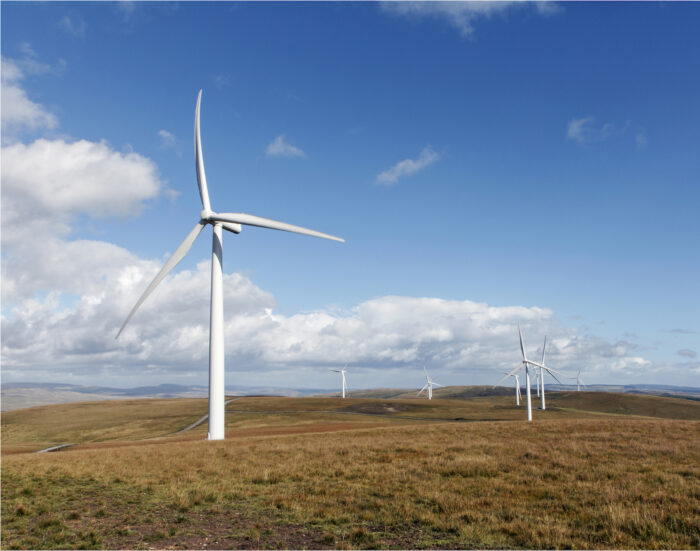Wind turbine
A renewable energy wind turbine uses wind power to generate electricity.

You may be used to seeing windfarms, which have been part of the UK’s electricity production since the early 1990s. Nowadays, domestic wind turbines are becoming increasingly popular. The electricity generated by a wind turbine for your home can power your appliances, be stored in a battery, or be exported to the National Grid.
Installing a wind turbine for your home
There are two ways to install a wind turbine for your home. It can either be pole mounted (freestanding) or attached to your home itself.
Pole mounted wind turbines are freestanding, just like the turbines you see at windfarms. They need to be put up in an area with lots of open space, where the wind is strong.
Pole mounted wind turbines typically generate around 6kw of electricity.
Building mounted wind turbines are attached to the roof of your home.
At Changeworks, we wouldn’t recommend installing a building mounted wind turbine. Attaching a wind turbine to your home puts strain on the building, which may result in structural damage.
Building mounted wind turbines typically only generate around 2kw of electricity. This means you won’t significantly reduce your reliance on the National Grid.
Horizontal and vertical wind turbines
There are two kinds of wind turbine for the home: horizontal axis and vertical axis wind turbines. The differences between them are:
- The way the rotor blades point
- Where the generator is placed
Horizontal wind turbine
Horizontal axis wind turbines (HAWT) are likely what most people think of if they picture a wind turbine. The blades face the wind, much like traditional windmills. The generators are placed at the top of the pole, behind the rotor.
Vertical wind turbine
With vertical axis wind turbines (VAWT), all the blades point downwards. They catch the wind more like sails on a boat.
Wind speed
As you’ve probably guessed, wind turbines work best in windy places. You need a reliable wind speed to make a turbine worthwhile.
You can get a good idea of the wind speed in your area with this tool from the Energy Saving Trust.
You should be looking for a wind speed of at least five meters per second. If the Energy Saving Trust tool says you have this, you can then take a more specific measurement. You’ll need to use an anemometer (which measures the speed and direction of the wind) at your site.
It’s important to get at least a year’s worth of data from the anemometer. This will help you work out whether the average wind speed is fast enough to power a turbine.
What size wind turbine do I need?
What size wind turbine you need depends on:
- The average windspeed at the site
- How much electricity you want to generate
Domestic wind turbines range in size from 1kW to 15kW.
Ofgem estimates that an average British household uses 2,900 kWh of electricity per year. The Energy Saving Trust states that a well-positioned 6kW wind turbine can generate around 9,000 kWh of electricity per year.
Based on these figures, it’s unlikely that a 1kW wind turbine would fully cover your electricity needs throughout the year. A 15kW turbine would likely produce way over what your household needs. The excess could be sold to the National Grid as part of the Smart Export Guarantee scheme.
How much does a wind turbine cost?
The cost of a pole mounted wind turbine depends on its size. The bigger the turbine, the higher the cost. A 6kW wind turbine costs around £31,000. This includes the cost of installation.
Grants for wind turbines
There are currently no grants available in Scotland for wind turbines. However, Home Energy Scotland offer an interest free loan of £2,500 towards the cost of a wind turbine.
Payments through the Smart Export Guarantee can also help you offset some of the cost.
Register your interest in EcoCosi from Changeworks
Find out more about how our home retrofit service can help make your home warmer and more comfortable, as well as lower your energy bills.

Changeworks delivers Home Energy Scotland in the south east and Highlands and Islands on behalf of the Scottish Government and Energy Saving Trust.
As well as providing free, impartial expert advice to thousands of people every month to help them to keep warm in their homes for less, they identify funding opportunities for households seeking to install energy efficiency measures.
For more information, give Home Energy Scotland a call on 0808 808 2282 or email and the team will be happy to help you.
Useful pages
Is this page useful?